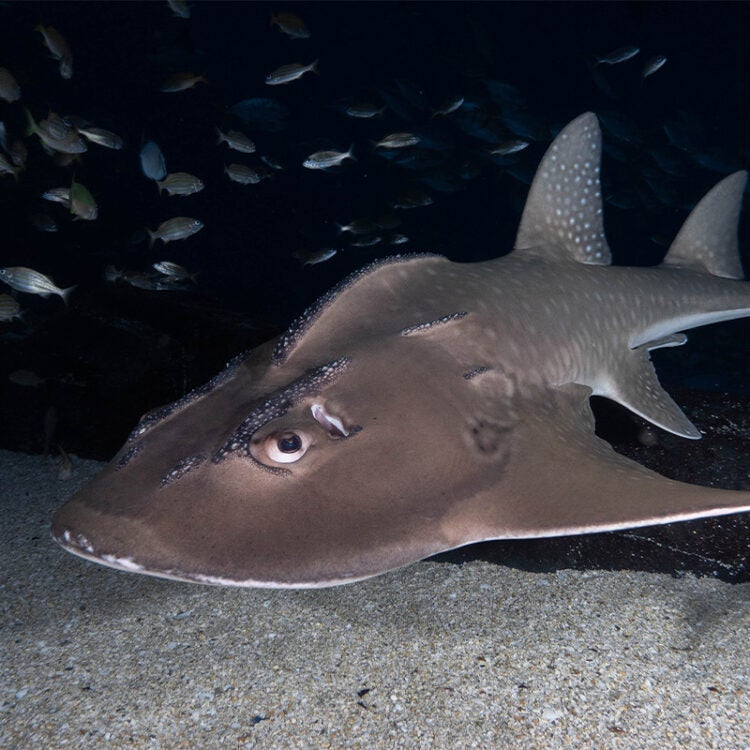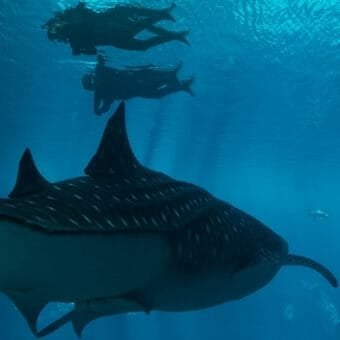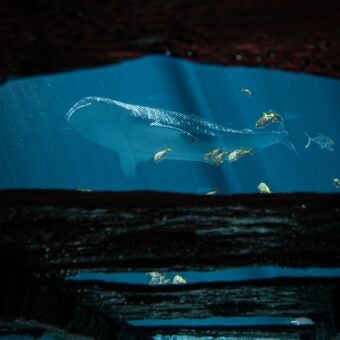-
Size
9.8 feet (3 m) -
Diet
Benthic crustaceans and mollusks -
Range
Indo-West Pacific -
Habitat
Sandy or muddy bottoms close to shore
Physical Characteristics
- Adults can reach approximately 9.8 feet (3 m) in length and have a maximum weight of about 298 lbs. (135 kg).
- Bowmouth guitarfish has a distinctive shape that resembles a cross between a shark and a ray, however, it is actually a member of the ray family.
- The front of its body is flattened and wide, while the rest of its body and the large dorsal fins create a shark-like appearance.
- A broadly rounded snout shows a row of spiky thorns on the bony ridges above both eyes and along the back and shoulders.
- The tail is longer than the body and the pectoral fins are large with a broad base typical of a ray.
- Adult coloration is grayish-brown in color with white spots on the dorsal fins and darker spots on the head and shoulders.
- Juveniles are brown to bluish-grey with large white spots, partial eye-spots on the pectoral fins and black spots between the eyes.
Animal Fact
The bowmouth guitarfish look a lot like sharks, but they are actually rays! Since sharks and rays are closely related, it can sometimes be hard to tell the difference. An easy way to tell is by looking at the location of the gill slits – if the gills are on the side of the fish, then you’re looking at a shark. If the gills are on the underside, however, then it’s a ray!
Diet / Feeding
- Feeds primarily on benthic crustaceans and mollusks such as shrimp, crabs, and clams.
Range / Habitat
- Occurs in the tropical waters of the Indo-West Pacific (including the Red Sea) including around East Africa, Papua New Guinea, Japan, and Australia.
- Usually found at depths up to 65 feet (20 m) on sandy or muddy bottoms close to shore or near coral reefs.
- This ray is usually seen swimming alone.
Reproduction & Growth
- Ovoviviparous, meaning it produces eggs that hatch within the mother’s body, and the young are born alive.
- The female usually gives birth to four young, each about 18 inches (45 cm) long.
Conservation Status
- “Critically Endangered” on the IUCN Red List.
Additional Information
- The bowmouth guitarfish has a row of large spines above the eye, on the center of the nape and on the shoulder has a defensive function and can be used for butting.
- Their jaws are heavily ridged, with crushing teeth in undulating rows.
- Also called a “shark ray.”
- Bowmouth guitarfish are often the bycatch of shrimp fishermen who consider it to be a nuisance because their spiky head makes it difficult to handle, and can damage their nets; however, the high value of the fins creates a significant incentive to retain an accidentally caught bowmouth guitarfish.
- This species is marketed commercially for human consumption in the western Pacific, though only the fins are eaten.
- Habitat destruction and pollution are thought to pose a significant threat.
Sources
- www.fishbase.org
- Reef Fish Identification. Allen, G.; Steene, R.; Humann, P. and Deloach, N., pg. 455





